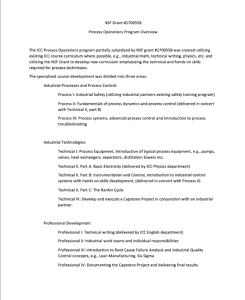Industrial Technologies III

Program Description:
The Process Operations program curriculum is provided by Itasca Community College (ICC) and was created utilizing existing ICC course curriculum where possible, e.g., industrial math, technical writing, physics, etc. The Process Operations curriculum was created with emphasis on the technical and hands-on skills required for process technicians.
The specialized course development was divided into the following three areas: Process Fundamentals, Industrial Technologies, & Professional Development. Industrial Technologies includes the following courses:
- Industrial Technologies I
- Industrial Technologies II (Parts B & C)
- Industrial Technologies III
- Industrial Technologies IV
Course Description:
ENGT 2220 Process Operations Technical III is intended to introduce students to the operator work documentation, procedures, and hands-on skills of the process operations industry. It is the third in a series of courses on technical knowledge and focuses on larger industrial equipment.
Course goals and outcomes include:
- Students will be able follow procedures, identify and fix incorrect procedures, and write procedures for use by others.
- Students will be able to recognize and understand how to manipulate manual, automatic, and cascade control systems.
- Students will be able to describe work orders, their correct use, and their importance in a working environment.
- Students will use process logs and incident reporting to log notes about the condition of the Hot Unit processes, current state of operations, abnormalities, and operational run time.
Course Contents:
Course materials include a program overview, a PowerPoint presentation, eleven student competency documents, and eight journal entry prompts. The 1-page Process Operations Program Overview document includes information about the National Science Foundation grant project that resulted in the development of this curriculum.
The student competency documents include information about each unit of the course, including outcomes, lectures, demonstrations, labs, and homework.
The journal entry documents contain a prompt for students to respond to and reflect upon the unit.
Below is a list of the files included in the .zip attachment. The size of each file is included in parenthesis.
Technical III (1.9 MB, 21 files)
- Work Orders (Technical III_8_24_2017.pptx 1.1MB)
- NSF Grant READ ME - Processing Operations Program Overview (NSF Grant READ ME.docx 13 KB)
- Student Competency 9 (9_Lubrication.docx 63 KB)
- Student Competency 8 (8_Hot Work.docx 62 KB)
- Journal Entry 8 (8. Journal Entry QuestionTechnical III.docx 44 KB)
- Student Competency 7 (7_Lock Out Tag Out.docx 64 KB)
- Journal Entry 7 (7. Journal Entry QuestionTechnical III.docx 43 KB)
- Student Competency 6 (6_Vibration Monitoring of Equipment.docx 64 KB)
- Journal Entry 6 (6. Journal Entry QuestionTechnical III.docx 43 KB)
- Student Competency 5 (5_Infrared Monitoring of Equipment.docx 63 KB)
- Journal Entry 5 (5. Journal Entry Question 9_7_2017.docx 41 KB)
- Student Competency 4 (4_Shift Records and Process Logs.docx 66 KB)
- Journal Entry 4 (4. Journal Entry Question 9_12_2017.docx 41 KB)
- Student Competency 3 (3_Equipment Inspection_Rounds Compatency.docx 66 KB)
- Journal Entry 3 (3. Journal Entry Question 9_5_2017.docx 44 KB)
- Student Competency 2 (2_Procedure Compatency.docx 66 KB)
- Journal Entry 2 (2. Journal Entry Question 8_31_2017.docx 41 KB)
- Student Competency 1 (1_Work Order_Systems Compatency.docx 67 KB)
- Journal Entry 1 (1_Journal Entry Question.docx 44 KB)
- Student Competency 11 (11_P&ID knowledge Manual, Auto, and Cascade Loop Recognition.docx 66 KB)
- Student Competency 10 (10_P&ID knowledge Manual, Auto, and Cascade Loop Recognition.docx 66 KB)
About this Resource

Comments